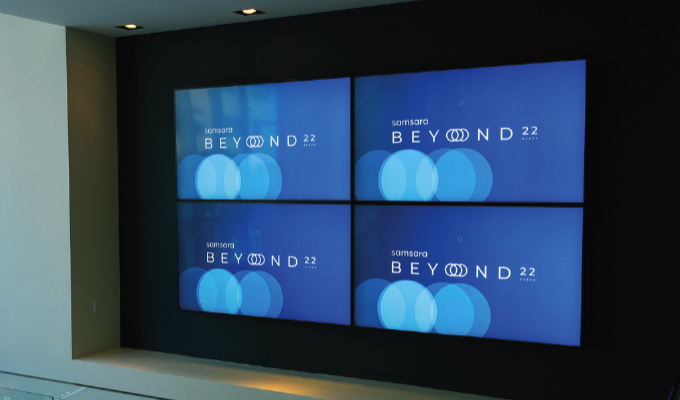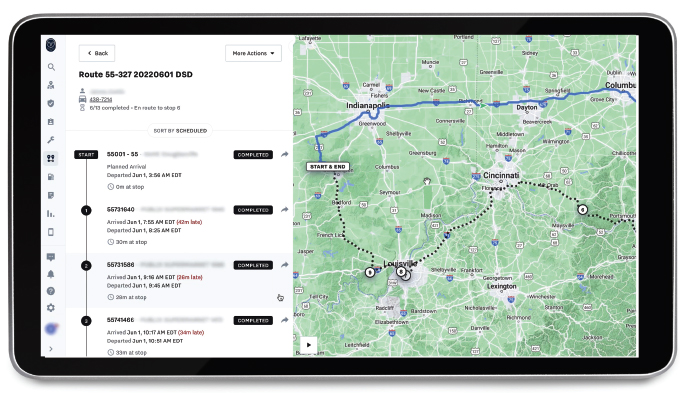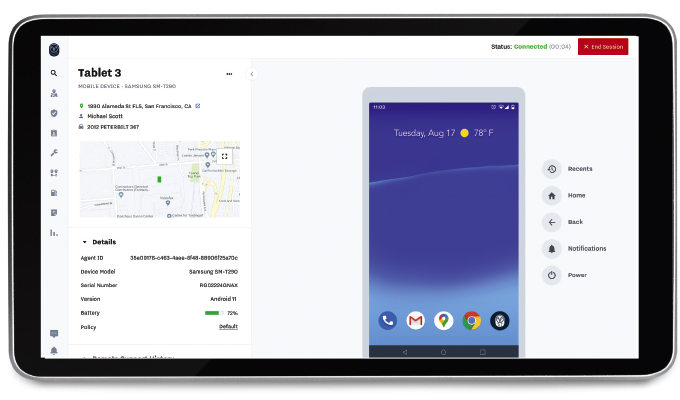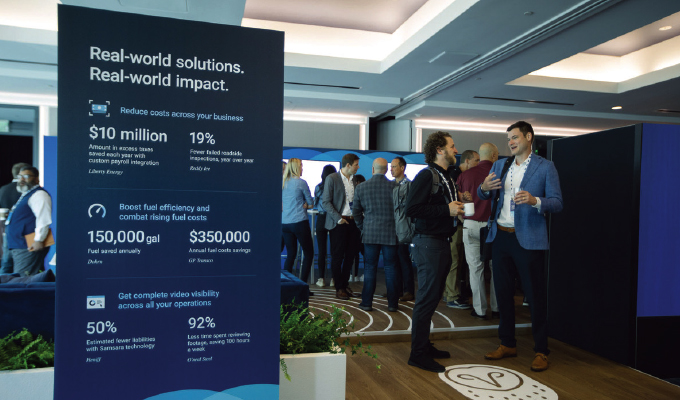Last month in San Francisco, Samsara, a technology company that harnesses fleet data to improve efficiency, safety, and sustainability, held its first customer conference, Beyond 2022. The conference showcased Samsara’s industry achievements and innovations, recognized customers that met sustainability and financial goals, and gave media and customers a look at Samsara’s realized and yet-to-be-tapped potential in the fleet industry.
The conference consisted of keynote speeches, breakout sessions, a partner exhibit hall, and an opportunity to experience Samsara’s Connected Operations Cloud through a hands-on demo. Speeches and breakout sessions included stats from Samsara’s operations within fleets, which helped everyone in attendance gain a better understanding of how Samsara could benefit their own fleet even further. Multiple examples were given of customers improving operations throughout the two-day event.
The conference showcased how connecting your fleet vehicles and drivers with back office personnel while using data to improve operations is a milestone in and of itself. However, co-founder and CEO, Sanjit Biswas, says Samsara is just getting started, and the company strives to be at the forefront of the next big wave of technology: connecting “things.” With the company’s newly announced innovations and partnerships, it seems Samsara is well on its way to connecting the entire fleet industry.

THE PLATFORM
For those that are unfamiliar with Samsara, the company essentially captures data upon data to provide customers with insight into how their fleet runs on a daily basis per driver, per truck, per trip, etc. Customers can access and view this data through reports via Samsara’s Connected Operations Cloud platform. The platform captures data from cameras, sensors, and OEM integrations to help fleets make informed decisions to improve their operations.
The platform can also house safety, telematics, maintenance, workflows, equipment monitoring, compliance, reporting, security, sustainability, efficiency, and data and integrations applications and statistics. The Connected Operations Cloud is truly a one-stop shop for fleet management, collecting all data in a central place in industries such as construction, beverage and food distribution, state and local government, field service, and transportation and logistics.
But, as Biswas stated in his keynote speech, all of this data isn’t limited only to the Samsara platform. Real companies have used this data for payroll, fuel theft prevention, compliance, and more. In fact, 150 Samsara partnerships across the industry feed into Samsara’s platform or offer services through Samsara to further improve fleet operations and “continue unlocking the power of data,” Biswas says.

INNOVATION EXPANSION
To simplify operations even further, Samsara introduced new innovations to integrate into the Connected Operations Cloud. These include Driver Workflows, In-cab Nudges, Multi-stop ETAs, and Remote Support.
Samsara designed its Driver Workflows to guide drivers and field operators through critical parts of their day. In the Samsara Driver App, drivers will see end-of-day workflows, customized workflows, and linked third-party tasks in one place.
In-cab Nudges are a new safety feature that allow drivers to self-correct risky behavior before requiring a coaching session. When a driver exhibits risky behavior, an AI-powered in-cab alert sounds, calling the behavior to the driver’s attention. If the driver takes no corrective action, then a manager will be notified. These alerts give drivers the opportunity to coach themselves while also helping to eliminate coaching sessions, saving time.
Multi-stop ETAs are another new innovation that provide dispatch accurate and up-to-date predicted arrival times—on all stops throughout the route. This real-time trip progress allows customers to know exactly when to expect service or delivery.
Finally, Remote Support allows administrators to control devices from anywhere. This includes a driver’s mobile device (with their permission, of course). This feature helps administrators troubleshoot issues and support their drivers regardless of their location.
FOUNDED ON FEEDBACK
When it comes to deciding what innovations to add to its platform, Samsara lets its customers decide. During a Q&A session with Sanjit Biswas and Kiren Sekar, Samsara chief product officer, it was stated that Samsara’s company roadmap is based on customer feedback. Customer feedback concerning the current labor shortage is what brought about Samsara’s Driver Workflows, which helps improve driver retention. Ultimately, drivers have their choice of who to drive for, and fleets that offer the most advanced tools for the job will experience better driver retention.
Another aspect of customer feedback that Samsara heard was that fuel savings is now more important than ever. Samsara’s data helps benchmark driver behaviors to see if specific actions improve fuel economy. Other ways to save money are through insurance and accident reduction. With Samsara, fleets can offer a snapshot of their drivers’ safety habits to their insurance provider. With data-driven insurance, coverage is provided in more specific and lucrative ways. Samsara video footage can also help exonerate drivers involved in an incident who weren’t at fault.
Connectivity issues was also a topic covered in the Q&A. With Samsara, fleet data is recorded and stored even when working in remote areas with no access to the internet or cellular data. This is because the Samsara product can store data locally and sync data to the cloud once connected to the internet again. Some Samsara-integrated cameras can even hold up to a week’s worth of footage, ensuring customers have all needs met no matter where they are.

PARTNERING UP
The main theme of the two-day event in San Francisco was “It’s only the beginning,” or “We’re just getting started.” Chris Mozzocchi, senior director of Samsara echoed that sentiment when discussing Samsara’s “ecosystem strategy.” According to Mozzocchi, a fleet ecosystem includes data and operations beyond the vehicle and the platform. It includes the technology and solutions customers currently use and what they have yet to tap into. “We want to make it as easy as possible for data to help with a multitude of things,” Mozzocchi says. He says the ecosystem is much broader than vehicle OEM collaboration, but Samsara does see OEM collaboration as a key pillar for data.
Speaking of OEMs, Samsara announced partnerships between General Motors and Stellantis (Ram) at the event. With a Ford partnership already in place, Samsara now has the ability to integrate with the majority of light-duty vehicles a fleet owner might have in operation. For medium-duty fleets and construction asset management, Samsara’s two-year partnership with Navistar and its partnership with Caterpillar and others has already proved beneficial. Fleets that own ThermoKing equipment can now also benefit from Samsara’s data, as the technology company announced a collaboration with ThermoKing as well. But Samsara won’t stop there. Mozzocchi expects more OEM partnerships to come.
These partnerships benefit both Samsara and the OEM because, ultimately, they benefit a shared customer: fleet owners. These collaborations keep both operations and in-cab hardware more streamlined so that drivers and fleet managers can focus on their job. This plethora of data, captured, analyzed, and filtered through Samsara, will become an operating system for businesses. It will help fleets conduct workflows, understand fuel and energy usage, see driver health and vehicle health, and more. Managers can even see their fleet’s operations against peer benchmarks.
GETTING STARTED
With the industry currently experiencing new changes and challenges every day, this data is definitely beneficial for fleets to learn how to adapt. But once the labor shortage decreases, gas prices lower, and the supply chain corrects itself, will all this data still be necessary for fleets? Biswas says “Definitely.”
The industry will continue to change. With electric vehicles becoming more common, autonomous vehicles on the horizon, and unforeseen industry challenges yet to come, fleets will see changes to their operations. Fleets with data at their fingertips will find it easier to adapt with the industry, and with Samsara’s expectation of growth and innovations, fleet adaptations will likely happen more easily. After all, Samsara is only just getting started.
FOR MORE INFORMATION
Find out more about Samsara, visit www.samsara.com.




